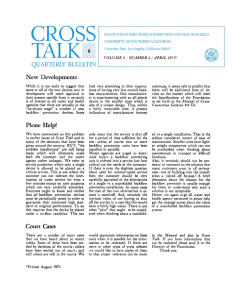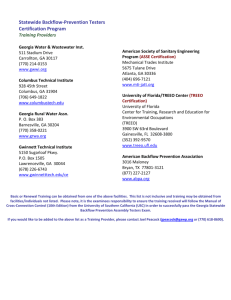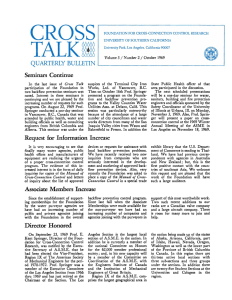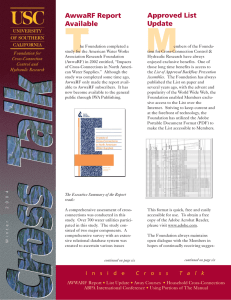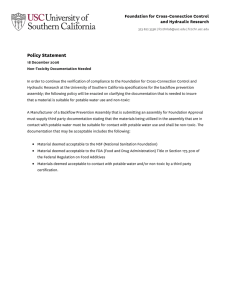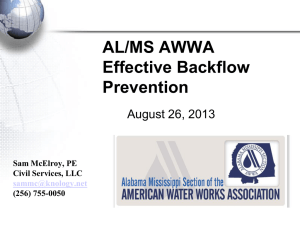CROSS TALK ~~ ~
advertisement
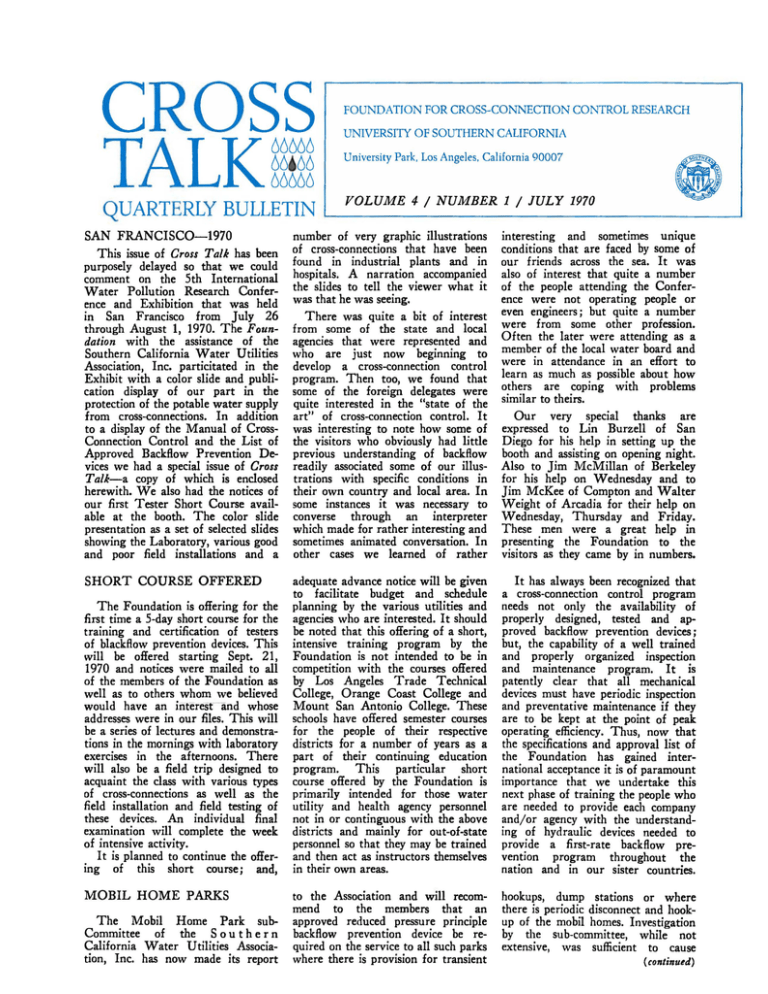
CROSS TALK 66666 ~~~~~ QUARTERLY BULLETIN FOUNDATION FOR CROSS-CONNECTION CONTROL RESEARCH UNIVERSITY OF SOUTHERN CALIFORNIA University Park. Los Angeles. California 90007 VOLUME 4 I NUMBER 1 I JULY 1970 SAN FRANCISC0-1970 This issue of Cross Talk has been purposely delayed so that we could comment on the 5th International Water Pollution Research Conference and Exhibition that was held in San Francisco from July 26 through August 1, 1970. The Foundation with the assistance of the Southern California Water Utilities Association, Inc. particitated in the Exhibit with a color slide and publication display of our part in the protection of the potable water supply from cross-connections. In addition to a display of the Manual of CrossConnection Control and the List of Approved Backflow Prevention Devices we had a special issue of Cross Talk-a copy of which is enclosed herewith. We also had the notices of our first Tester Short Course available at the booth. The color slide presentation as a set of selected slides showing the Laboratory, various good and poor field installations and a number of very graphic illustrations of cross-connections that have been found in industrial plants and in hospitals. A narration accompanied the slides to tell the viewer what it was that he was seeing. There was quite a bit of interest from some of the state and local agencies that were represented and who are just now beginning to develop a cross-connection control program. Then too, we found that some of the foreign delegates were quite interested in the "state of the art" of cross-connection control. It was interesting to note how some of the visitors who obviously had little previous understanding of backflow readily associated some of our illustrations with specific conditions in their own country and local area. In some instances it was necessary to converse through an interpreter which made for rather interesting and sometimes animated conversation. In other cases we learned of rather interesting and sometimes unique conditions that are faced by some of our friends across the sea. It was also of interest that quite a number of the people attending the Conference were not operating people or even engineers; but quite a number were from some other profession. Often the later were attending as a member of the local water board and were in attendance in an effort to learn as much as possible about how others are coping with problems similar to theirs. Our very special thanks are expressed to Lin Burzell of San Diego for his help in setting up the booth and assisting on opening night. Also to Jim McMillan of Berkeley for his help on Wednesday and to Jim McKee of Compton and Walter Weight of Arcadia for their help on Wednesday, Thursday and Friday. These men were a great help in presenting the Foundation to the visitors as they came by in numbers. SHORT COURSE OFFERED adequate advance notice will be given to facilitate budget and schedule planning by the various utilities and agencies who are interested. It should be noted that this offering of a short, intensive training program by the Foundation is not intended to be in competition with the courses offered by Los Angeles Trade Technical College, Orange Coast College and Mount San Antonio College. These schools have offered semester courses for the people of their respective districts for a number of years as a part of their continuing education program. This particular short course offered by the Foundation is primarily intended for those water utility and health agency personnel not in or continguous with the above districts and mainly for out-of-state personnel so that they may be trained and then act as instructors themselves in their own areas. It has always been recognized that a cross-connection control program needs not only the availability of properly designed, tested and approved backflow prevention devices; but, the capability of a well trained and properly organized inspection and maintenance program. It is patently clear that all mechanical devices must have periodic inspection and preventative maintenance if they are to be kept at the point of peak operating efficiency. Thus, now that the specifications and approval list of the Foundation has gained international acceptance it is of paramount importance that we undertake this next phase of training the people who are needed to provide each company and/or agency with the understanding of hydraulic devices needed to provide a first-rate backflow prevention program throughout the nation and in our sister countries. to the Association and will recommend to the members that an approved reduced pressure principle backflow prevention device be required on the service to all such parks where there is provision for transient hookups, dump stations or where there is periodic disconnect and hookup of the mobil homes. Investigation by the sub-committee, while not extensive, was sufficient to cause The Foundation is offering for the first time a 5-day short course for the training and certification of testers of blackflow prevention devices. This will be offered starting Sept. 21, 1970 and notices were mailed to all of the members of the Foundation as well as to others whom we believed would have an interest and whose addresses were in our files. This will be a series of lectures and demonstrations in the mornings with laboratory exercises in the afternoons. There will also be a field trip designed to acquaint the class with various types of cross-connections as well as the field installation and field testing of these devices. An individual final examination will complete the week of intensive activity. It is planned to continue the offering of this short course; and, MOBIL HOME PARKS The Mobil Home Park subCommittee of the Southern California Water Utilities Association, Inc. has now made its report ( continu~d) grave concern over the safety of the supply system to such developments unless the maximum level of protection were provided. In a few cases where an installation has been in existence for many years the trailer court, as it was then called, is now normally surrounded by other developments so that it can not expand to accomodate overnight parking and usually has no particular need for a dump station. Furthermore, the trailer homes of this type park have been "in place" for quite a long time and are not periodically disconnected and another unit reconnected to these utility services. In such a case some discretion may be exercised. However, in most recent installations of mobil home parks there is provision for transcient trailers, dump stations, and basic design and construction hazards that certainly appear to offer the maximum potential for direct crossconnections. In some instrances it has been reported that all service connections are brought up in a hookup island in such a fashion that the water and sewer connections are so close together that it is quite possible to contaminate the water line while hooking up the sewer line. And, in more than one instance the flexible connection lines for water and sewer were actually strapped together. Other installations have auxiliary equipment within the park which can cause backwash water to build up ;;ufficient pressure to cause potential backflow. Also, some installations were reported where both water and sewer lines were allowed to be laid in a step trench. There has been one instance where a water bourne infection was traced to a step trench installation. There is also the problem of the extension of lines within the park after the original completion of the development. This extension of service has been found to be the basis of quite a number of orders requiring the up-grading of the service protection to reduced pressure principle devices. Also, in order that these do-it-yourself changes are at least known and recognized it has been suggested by some concerned parties that a certification of compliance with the backflow prevention ordinance be required as a condition for the renewal of the business license of the park. To a water agency or company whose service area does not include a mobil home park this matter may seem to be an academic question. However, it should be recognized that some surveys indicate that in the next decade or two the number of mobil homes purchased will account for as much as 50% of the low to moderate new home market. In many cases these new mobil homes will be installed in relatively large "master planned" developments which will have requirements for major fire line service as well as domestic and irrigation water service along with the other utilities. A number of the fire districts are now requiring a minimum capacity of 500 gpm for each of the two adjacent fire hydrants farthest from the point of service; and, at least one fire department is demanding a capacity of 1000 gpm at the most remote hydraunt in the mobil home park. Hence, now is the time when advance planning must be accomplished. NEW APPROVALS These units are: a) 3" Double Check Valve Assembly approved under the specifications of the 4th Edition of the MANUAL OF CROSSCONNECTION CONTROL; b) 4" Reduced Presssure Principle Assembly approved under the specifications of the 3rd Edition of the MANUAL: and c) 6" Reduced Pressure Principle Assembly approved under the specifications of the 3rd Edition of the MANUAL. Other units are currently undergoing field evaluations which hopefully will be added to the Approved List in the near future. Also, two companies new to the field have inquired about the approval program and have now submitted their drawings and specifications for one size device as the first step toward gaining the approval of the Foundation. This increased interest in the development of backflow prevention equipment is really heartwarming news to those pioneers who labored so long to get this health program underway. During the last quarter three backflow prevention devices have passed all of the laboratory and field specifications of the Foundation and have been added to the List of Approved Backflow Prevention Devices. An updated list has been mailed to all members of the Foundation. Others needing the current list may receive one by writing to the Foundation. The new units that have just completed the field service period are products of the Cla-Val Company of Newport Beach and Alhambra, Calif. 666666666666666 666666666666666 666666666666666 UNIVERSITY OF SOUTIIERN CALIFORNIA SCHOOLOPENG~G IJNlVI!RSlTY PARK LOS ANGELES, CAIJR>RNA 90007 Non-profit Org. U.S. Postage PAID Permit No. 2075 Los Angeles, Calif.
